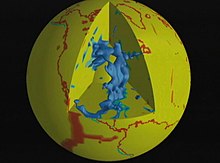Slab (geology)

A model of the subducting Farallon Slab under North America
In geology, a slab is the portion of a tectonic plate that is being subducted.[1]
Slabs constitute an important part of the global plate tectonic system. They drive plate tectonics – both by pulling along the lithosphere to which they are attached in a processes known as slab pull and by inciting currents in the mantle (slab suction).[2] They cause volcanism due to flux melting of the mantle wedge, and they affect the flow and thermal evolution of the Earth's mantle. Their motion can cause dynamic uplift and subsidence of the Earth's surface, forming shallow seaways[3] and potentially rearranging drainage patterns.[4]
Geologists have imaged slabs down to the seismic discontinuities between the upper and lower mantle and to the core–mantle boundary. About 100 slabs have been described at depth, and where and when they subducted.[5] Slab subduction is the mechanism by which lithospheric material is mixed back into the Earth's mantle.
See also
Slab window – A gap that forms in a subducted oceanic plate when a mid-ocean ridge meets with a subduction zone and the ridge is subducted
References
^ Conrad, C. P. "How Mantle Slabs Drive Plate Motions". Archived from the original on June 13, 2011. Retrieved 24 April 2011..mw-parser-output cite.citation{font-style:inherit}.mw-parser-output .citation q{quotes:"""""""'""'"}.mw-parser-output .citation .cs1-lock-free a{background:url("//upload.wikimedia.org/wikipedia/commons/thumb/6/65/Lock-green.svg/9px-Lock-green.svg.png")no-repeat;background-position:right .1em center}.mw-parser-output .citation .cs1-lock-limited a,.mw-parser-output .citation .cs1-lock-registration a{background:url("//upload.wikimedia.org/wikipedia/commons/thumb/d/d6/Lock-gray-alt-2.svg/9px-Lock-gray-alt-2.svg.png")no-repeat;background-position:right .1em center}.mw-parser-output .citation .cs1-lock-subscription a{background:url("//upload.wikimedia.org/wikipedia/commons/thumb/a/aa/Lock-red-alt-2.svg/9px-Lock-red-alt-2.svg.png")no-repeat;background-position:right .1em center}.mw-parser-output .cs1-subscription,.mw-parser-output .cs1-registration{color:#555}.mw-parser-output .cs1-subscription span,.mw-parser-output .cs1-registration span{border-bottom:1px dotted;cursor:help}.mw-parser-output .cs1-ws-icon a{background:url("//upload.wikimedia.org/wikipedia/commons/thumb/4/4c/Wikisource-logo.svg/12px-Wikisource-logo.svg.png")no-repeat;background-position:right .1em center}.mw-parser-output code.cs1-code{color:inherit;background:inherit;border:inherit;padding:inherit}.mw-parser-output .cs1-hidden-error{display:none;font-size:100%}.mw-parser-output .cs1-visible-error{font-size:100%}.mw-parser-output .cs1-maint{display:none;color:#33aa33;margin-left:0.3em}.mw-parser-output .cs1-subscription,.mw-parser-output .cs1-registration,.mw-parser-output .cs1-format{font-size:95%}.mw-parser-output .cs1-kern-left,.mw-parser-output .cs1-kern-wl-left{padding-left:0.2em}.mw-parser-output .cs1-kern-right,.mw-parser-output .cs1-kern-wl-right{padding-right:0.2em}
^ Conrad, C. P.; Lithgow-Bertelloni, C (2002). "How Mantle Slabs Drive Plate Tectonics". Science. 298 (5591): 207–09. Bibcode:2002Sci...298..207C. doi:10.1126/science.1074161. PMID 12364804.
^ Mitrovica, J. X.; Beaumont, C.; Jarvis, G. T. (1989). "Tilting of continental interiors by the dynamical effects of subduction". Tectonics. 8 (5): 1079. Bibcode:1989Tecto...8.1079M. doi:10.1029/TC008i005p01079.
^
Shephard, G. E.; Müller, R. D.; Liu, L.; Gurnis, M. (2010). "Miocene drainage reversal of the Amazon River driven by plate–mantle interaction". Nature Geoscience. 3 (12): 870–75. Bibcode:2010NatGe...3..870S. CiteSeerX 10.1.1.653.4596. doi:10.1038/ngeo1017.
^ "Atlas of the Underworld | Van der Meer, D.G., van Hinsbergen, D.J.J., and Spakman, W., 2017, Atlas of the Underworld: slab remnants in the mantle, their sinking history, and a new outlook on lower mantle viscosity, Tectonophysics". www.atlas-of-the-underworld.org. Retrieved 2017-12-02.
This tectonics article is a stub. You can help Wikipedia by expanding it. |